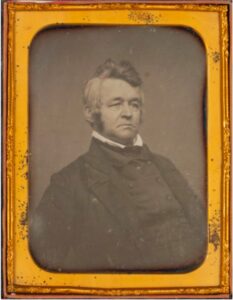
Bowdoin’s Special Collections & Archives recently received the medical library of Dr. John Hubbard (1794-1869), a prominent physician, governor of Maine representing the Democratic Party from 1850 to 1853, and father to Thomas Hubbard, Bowdoin class of 1857 and namesake of Hubbard Hall. The collection is a gift of the Hubbard Free Library in Hallowell, Maine, where Hubbard practiced medicine for nearly 40 years.
Containing more than 260 volumes, Hubbard’s library offers a window into the life and work of a 19th century physician operating a solo practice in a bustling town. The books in his collection range from the very practical—anatomical and surgical manuals—to philosophical ones about the classification of epidemical diseases. Some of the oldest (1793) and most recent (1866) imprints concern women’s reproductive health, as do numerous others, pointing to the frequency with which Hubbard attended to obstetrical work. His library suggests he also made every effort to keep up with the most recent developments in his field. Hubbard subscribed to the American Journal of Medical Sciences and continued to acquire new publications throughout his life, including those on the burgeoning use of ether, magnetism, and electricity in medical care.
Upon his death, his medical office was sealed, and it remained a virtual time capsule for more than a century. His books were eventually transferred to the Hubbard Free Library in Hallowell, but never cataloged. In 2019, the trustees of the library voted to transfer them to Bowdoin College, partially in recognition of the Hubbard family’s strong connections with the College but also as a means of recognizing Bowdoin’s important role in Maine medicine.
Samuel Scofield, M.D.’s "A Practical Treatise on Vaccina or Cowpock." New York: Southwick and Pelsue; Collins & Perkins, 1810.
Samuel Scofield served as one of the physicians of the New York Dispensary and the first resident surgeon of the New York Institution for the Inoculation of the Cowpock. Scofield, a student of Dr. Valentine Seaman, the physician who introduced the smallpox vaccine to the United States and mapped yellow fever in New York City, wrote this text to serve as a practical handbook for practitioners, especially those he anticipated had not yet encountered the groundbreaking work of Dr. Seaman and Dr. Edward Jenners, the English physician and scientist respectively who pioneered the concept of vaccines and created the smallpox vaccine, the world’s first vaccine.
